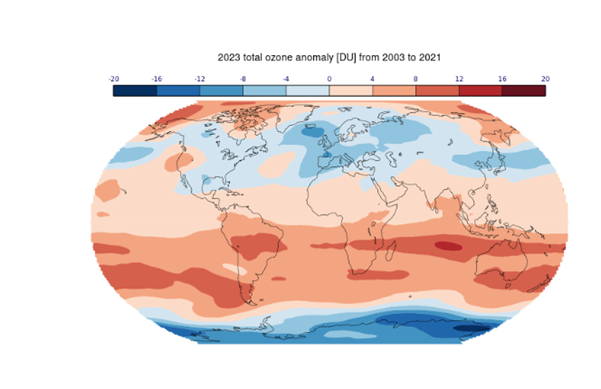WMO Ozone and UV Bulletin published for World Ozone Day
The World Meteorological Organization has issued its annual WMO Ozone and UV Bulletin, with information on the state of the ozone layer and on measures to protect human health and the environment from damaging ultraviolet radiation.

The WMO Ozone and UV Bulletin explores the role of meteorological conditions and a major volcanic eruption on the Antarctic ozone hole in 2023, whilst highlighting growing evidence that the ozone layer is indeed on track to long-term recovery. Atmospheric abundances of tropospheric chlorine and bromine from long-lived ozone-depleting substances have continued to decline, it says.
Given that some ozone-depleting substances also function as greenhouse gases, their phaseout is an added bonus for the climate, it says, whilst stressing the need for continued monitoring and to avoid complacency.
The bulletin was published to coincide with World Ozone Day, which celebrates the most successful environmental treaty of all time - the Montreal Protocol, which led to the phaseout of damaging ozone-depleting substances. The theme selected by the UN Environment Programme this year is Montreal Protocol: Advancing Climate Action.
“The ozone layer, once an ailing patient, is on the road to recovery,” said UN Secretary-General António Guterres in a message. “At a time when multilateralism is under severe strain, the Montreal Protocol to help protect the ozone layer stands out as a powerful symbol of hope.”
“Now, it’s time to go further. The Protocol’s Kigali Amendment -- which focuses on phasing down hydrofluorocarbons (HFCs) – powerful climate-warming gases – can contribute to advancing climate mitigation efforts, protecting people and planet. And that is needed more than ever as temperature records continue to shatter. If fully ratified and implemented, the Kigali Amendment could help avoid as much as 0.5 degrees Celsius of global heating by the end of this century,” said Mr Guterres in a message which was also echoed by UNEP Executive Director Inger Andersen.
If current policies remain in place, the ozone layer is expected to recover to 1980 values (before the appearance of the ozone hole) by around 2066 over the Antarctic, by 2045 over the Arctic and by 2040 for the rest of the world. The Antarctic ozone hole has been slowly improving in area and depth since the year 2000, according to the most recent (2022) scientific assessment which was supported by UNEP and WMO.
“From its inception up to the present day, one of the pillars of the Montreal Protocol has been its foundation in very high-quality science,” said Matt Tully, Chair, WMO Scientific Advisory Group on Ozone and Solar UV Radiation.
“The WMO Global Atmosphere Watch (GAW) Programme continues to play an essential role in supporting ozone science through observations, analysis, modelling, data stewardship and capacity-building. It is critical that observations of ozone, ozone-depleting substances and ultraviolet (UV) radiation are maintained with the quality, resolution and global coverage necessary to account for changes in ozone over the coming decades. Many factors will influence the expected recovery of ozone, which must be fully measured and understood,” wrote Matt Tully in the bulletin.
2023 Ozone Hole
Total column ozone values in 2023 were within the range observed in previous years and in line with expectations, owing to the beginning of the decline of ozone-depleting chlorine and bromine in the stratosphere.
The 2023 Antarctic ozone hole was marked by two unusual characteristics: an early onset in late August, and persistence well into December.
The important eruption of Tonga’s Hunga Tonga-Hunga Ha’apai volcano on 15 January 2022 increased the amount of water vapour in the stratosphere and resulted in some ozone transport changes.

Overall, the two key unusual characteristics do not challenge the recent findings that recovery of ozone in the Antarctic ozone hole has started. They do, however, highlight that there are relatively rare atmospheric events that can have a significant impact on the Antarctic ozone hole; that there is much variability at timescales from days to years in the development of the Antarctic ozone hole; that there are still gaps in the scientific understanding of that variability; and that it remains crucial to maintain an observational infrastructure that enables us to attribute unusual or unexpected variations to particular geophysical processes and events.
Ozone Research Managers
The Ozone Research Managers (ORM) meet every three years to regularly review the status and needs of international ozone monitoring and research.
At the most recent session in April, hosted by WMO, the Ozone Research Managers stressed that continued scientific work is needed to measure, understand and model the past and future distribution and trends of ozone and UV radiation.
Recommendations were made in five thematic areas: research needs, systematic observations, gaps in the global coverage of controlled substances, data archiving and stewardship, and capacity-building.
WMO’s Global Atmosphere Watch has an important role to play in all five of these areas.




